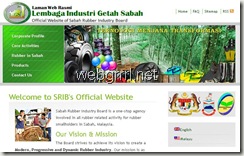Another annual assessment of Malaysian federal and state government websites by MSC Malaysia has passed.
Compared to last year with just 5 websites, open source CMSes — mainly Joomla, Drupal and WordPress –- are utilized by a whopping 14 sites in the Top 20-ranked Sabah ministries/departments/agencies.
And, as you can see below, Sabah Rubber Industry Board, the website I maintained, jumped from 11th ranking in 2011, to 2nd in 2012. Oh yeah.
- Sabah State Syariah Judicial Department: Joomla
- Sabah Rubber Industry Board: WordPress (YIPPEE!)
- Shared by:
Sabah State Water Department: Drupal
Sabah Industrial Development and Research Department: Drupal - Shared by:
Sabah State Treasury Department: static/HTML
Sabah Tourism Board: dynamic/PHP framework - Putatan District Office: Joomla
- Sabah State Government: dynamic/ASP
- Sabah State Forestry Department: Joomla
- Shared by:
Sabah Rural Development Corporation: static/HTML
Sabah Human Resource Development Department: Joomla - Sabah State Ministry of Resource Development and IT Advancement: Drupal
- Shared by:
Sabah State Computer Department: dynamic/ASP
Beluran District Council: static/HTML
Menumbok Sub-District Office: static/HTML - Shared by:
Sabah State Public Sector Training Institute (INSAN): static/HTML
Sabah State Veterinary Department: Drupal - Sabah State Ministry of Local Government and Housing: static/HTML
- Sabah State Library: static/HTML
- Shared by:
Sabah State Department of Works: static/HTML
Sabah State Land and Survey Department: dynamic/ColdFusion
Sabah State Cultural Board: Drupal - Sabah State Finance Ministry: some dynamic/PHP, but mainly static/PHP
- Shared by:
Sabah State Public Welfare Services Department: static/HTML
Sabah State Youth and Sports Ministry: Drupal
Sabah Ministry of Rural Development: static/HTML - Sabah State Public Services Department: static/HTML
- Shared by:
Sabah Ministry of Community Development and Consumer Affairs: static/HTML
Sabah Ministry of Agriculture and Food Industry: static/HTML
Sandakan Municipal Council: ColdFusion - Shared by:
Sabah State Islamic Affairs Department: Joomla
Keningau District Office: Joomla
Lahad Datu District Office: static/HTML - Shared by:
Sabah Printing Department: static/HTML
Sabah State Ministry of Tourism, Culture and Environment: WordPress
Sabah State Liaisons Office: static/HTML
(Taken from list compiled for Sabah CIO Conference November 2012 (link removed, site no longer exist); analysis of CMS type done by yours truly using Wappalyzer)
Brief analysis
Sabah Rubber Industry Board (SRIB) now has a brother from another mother in the form of number 20, Sabah State Ministry of Tourism, Culture and Environment. The WordPress-powered site is beautifully made, with its content updated frequently. I personally am proud to see this site done so well, especially the fact that I am a huge fan of the social-media savvy State Minister, Masidi Manjun.
I’m waiting on closer “brother” of Sabah Rubber, the Sabah State Department of Fisheries, to jump onto the WordPress bandwagon, seeing that its head of department, Ray S.T., is already avidly blogging on the WordPress.com platform (Datuk, if you’re reading this, give me a buzz if you need any advice on setting up WP for your department; my advice is always free, as it has always been ages ago).
Out of a total of 36 websites ranked in the Top 20 listed above, Drupal shares the lead with Joomla with six websites respectively, followed by WordPress with two. This sudden huge use of Drupal could be explained by the fact that the State Computer Services Department (JPKN) has been helping a few departments to set up their CMSes, with Drupal as the platform of choice. At least half of the Joomla sites are outsourced, while Ministry of Tourism’s site is also outsourced. This fact matters little, as long as its end users (the government agencies) understand the extensibility that open source CMSes can offer.
My one sen
Whilst I’m happy that more government agencies are adopting open source CMS to power their websites, it’s important to note that most of the sites, including Sabah Rubber, has a lot to address when it comes to mobile accessibility and usefulness.
I see that many government departments are still too hung-up on aesthetics, as if making the website up-to-date almost always mean that the design and layout of the website has to be changed.
Also, I know that a few of the smaller departments and districts would feel a little disheartened when they see these fancy-schmancy websites using full-blown CMSes, and thinking, why, WE don’t have the resources + knowledge + time to make THAT!
The main idea has always been about delivering government product or service innovatively, and not about how much eye-candy they can put in their sites. A website is just one of the gateways to enable that. Luckily, Sabah state governments and agencies can always look to the marvelous people at the State Computer Services Department as well as the Ministry of HR&IT for support, advice, and even educating and training them to build one.
It is also always important to emphasize the planning aspects of building a website. The departments and agencies need to know what to do with the site, build an objective, have a purpose to achieve, set targets. Even more critical is the fact that they must rethink and re-engineer they way they deliver these services.
Spare us the red tapes, don’t make us, the people, deal with it. It’s the department’s problem to deal with it, and deal with it efficiently (read: FAST!).
You can always contact me for advice, too. As I said, my advice is open source, like WordPress — always free and available for use for the good of humankind.
Check out my other posts: « To-do list for 2013 / WordPress widget: One down, more to go »

Thank you for article. I follow you daily.